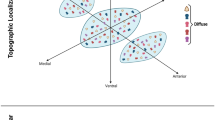Summary
-
1.
The fibre of Reissner (RF) a secretion of the subcommissural organ (SCO) was proved 1 to 24 hours after injections of3H-alanine,3H-tyrosine and35S-cystine into the lateral ventricle of cats. The amino acids were given by a cannula implanted 14 days before.
-
2.
The kind of the tyrosine-labelling of Reissner's fibre cannot be explained as labelling of elements, i.e. as an insertion of the tyrosine into the secretion taking place in the SCO, nor as a postmortal artefact, i.e. as attachment of tyrosine to the RF by formaline-fixation.
But it must be accepted, that there exists the possibility of a chemical binding between tyrosine and the glycoproteid of RF in vivo. The necessary anchor-groups might partly be delivered by the N-acetylneuraminic acid of the RF.
Zusammenfassung
-
1.
Mit der Untersuchung wurde das Verhalten des vom Subcommissuralorgan gebildeten Reissnerschen Fadens 1–24 Std nach Injektion von3H-Tyrosin,3H-Alanin und35S-Cystin in den Seitenventrikel von Katzen geprüft. Die Verabreichung der Aminosäuren erfolgte über eingeheilte Kanülen.
-
2.
Die Art der Tyrosin-Markierung des RF läßt sich weder als Bausteinmarkierung, d.h. als im SCO stattfindender Einbau des Tyrosins in das Sekret, noch als postmortaler Artefakt, d.h. als Anlagerung von Tyrosin an den RF durch Formalin-fixierung erklären.
Vielmehr muß angenommen werden, daß es in vivo zu einer chemischen Bindung zwischen Tyrosin und dem Glykoproteid des RF kommen kann. Die notwendigen Ankergruppen könnten zum Teil von der im RF enthaltenen N-Acetyl-Neuraminsäure geliefert werden.
Similar content being viewed by others
Literatur
Ermisch, A., G. Sterba, G. Hartmann u.H. Freyer: Autoradiographische Untersuchungen über das Wachstum des Reissnerschen Fadens von Cyprinus carpio (L.). Z. Zellforsch.91, 220–235 (1968).
Schultze, B.: Die Orthologie und Pathologie des Nucleinsäure- und Eiweißstoffwechsels der Zelle im Autoradiogramm. In: Handbuch der allgemeinen Pathologie, Band 2, Teil 5, S. 466–670. Berlin-Heidelberg-New York: Springer 1968.
Sterba, G., u.A. Ermisch: Der Reissnersche Faden als Rezeptormodell für biogene Amine: I. Bindung von Noradrenalin und Adrenalin. Acta biol. med. germ.22, K 9–14 (1969).
——,K. Freyer u.G. Hartmann: Incorporation of Sulphur-35 into the Subcommissural Organ and Reissner's Fibre. Nature (Lond.)216, 504 (1967).
—, u.G. Wolf: Vorkommen und Funktion der Sialinsäure im Reissnerschen Faden. Histochemie17, 57–63 (1969).
——, u.G. Scheuner: Polarisationsoptische Eigenschaften des Reissnerschen Fadens. Naturwissenschaften54, 495 (1967).
Wolf, G.: Über die physikalischen und biochemischen Eigenschaften des Reissnerschen Fadens. Intern. Symp. Circumventriculäre, Organe und Liquor, Schloß Reinhardsbrunn 1968. Jena: VEB G. Fischer (im Druck) (1969).
Author information
Authors and Affiliations
Rights and permissions
About this article
Cite this article
Sterba, G., Hess, J. & Ermisch, A. Der Reissnersche Faden als Receptormodell für biogene Amine. Pflugers Arch. 310, 277–280 (1969). https://doi.org/10.1007/BF00587215
Received:
Issue Date:
DOI: https://doi.org/10.1007/BF00587215




